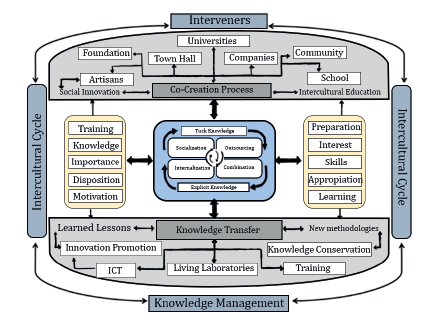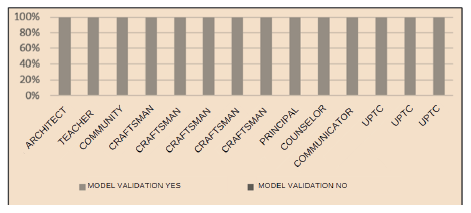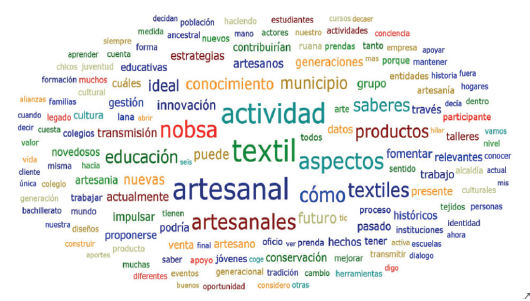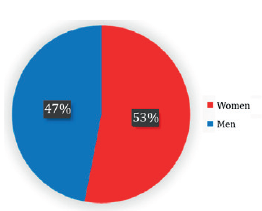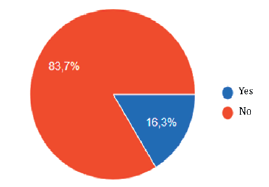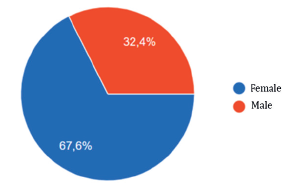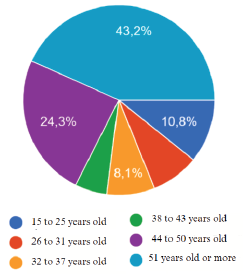INTRODUCTION
Nobsa, officially founded in 1593, in the Muisca language means "illustrious name of a person" or, for some historians, it is recognized as "your blanket" or "land of nobility". According to the census carried out in Colombia (DANE, 2005), the population of Nobsa was 15,194 people; among the most notable economic activities, the production of traditional handicrafts stands out, being recognized nationally for the production of ruanas (Artesanías de Colombia, 2019). The sheep wool industry offered in the municipality has the ruana as its specific product and is part of the traditional clothing of the people of Boyacá.
This article presents part of the results of the research entitled "Design of a Knowledge Management Model as Educational Support for Interculturality to Foster the Conservation of Artisanal Knowledge, Carried Out in Nobsa Boyacá." The knowledge management model was proposed as a tool for social innovation to reduce the acculturation of textile craft practices. In the development of this research, 37 artisans and 49 students from the ninth and tenth grades of the local high school participated, which allowed the rescue of textile craft knowledge and boosted cultural entre-preneurship as the axis in the economic development of the new generations of the municipality.
The implementation of the model was previously validated with social actors from the region, including representatives of the academy, the state, artisans, and the community in general. It should be noted that 40% of the artisans in the community received the knowledge through the teaching of a member of their family (Artesanías de Colombia, 2020). This shows that families are a determinant axis for the transmission of knowledge, which is confirmed in this article. In this way, it is evident that this type of work contributes to the reduction of generational gaps as a part of the strengthening of the cultural knowledge that sought to avoid the disappearance of the textile knowledge related to weaving.
Knowledge leakage is considered as the loss of expertise due to depreciation or unlearning of the inherent concepts of the management process (DAFP, 2021). The research defined the situation of knowledge management and social innovation. To this end, it identified the preservation of the current artisanal textile knowledge and the relevance of the practices in the process of preserving the weaving techniques.
Social innovation is a process built from the interaction of companies, organizations, institutions, and social actors to solve problems by generating new practices (Daniel & Jenner, 2022). In this regard, the present article emphasizes how social innovation results from the co-development of solutions to common problems, integrating community members with textile activities to reduce the loss of tradition and trade. To achieve this, living laboratories of the processes were carried out with public-private collaboration, integrating different interveners to promote meeting spaces that promote artisanal textile practices and reduce knowledge leakage.
The design of the developed knowledge management model was built based on the context and its realities to establish the transmission of the intellectual asset of traditional weaving, which is mainly found in the knowledge of the community artisans, showing the characteristics of their work, known as tacit knowledge. This type of knowledge is described as not codified knowledge, usually loaded with subjectivities and intuitions generated by personal experience (Avendaño & Flores, 2016). Continuing and seeking the creation of preservation, the developed knowledge management model was structured to facilitate the transfer of knowledge.
Meza et al. (2017) and Lawrence (2018) state that innovation in the design process is fundamental to the creative and cultural economy, where all the organizational knowledge is destined to open strategies that avoid knowledge leakage and the loss of intellectual assets. Consequently, it notes that the preservation of the traditions must favor an approach that gives the products differenttiated aspects, allowing them to obtain better profit margins. In the same way, Manquillo (2019) defines crafts as traditional knowledge that must be rooted in an exclusive context, where it manages to add value to the products to satisfy the final consumer. Therefore, innovation is established as a key resource due to its potential as a catalyst for newly established concepts to promote knowledge management within artisanal organizations.
In another vein, Nonaka and Takeuchi (1994) and Rubio et al. (2018) point out that the creation of management knowledge is a spiral process that starts at an individual level and is finally linked to a group level. In this regard, the function of the model has contributed to the promotion of artisanal textile practices, from social innovation that facilitates the link between the individual levels, resulting in the creation of social groups as part of the textile artisanal process.
Likewise, Shafi et al. (2019), Usman et al. (2019), and Kozlowski et al. (2018) support the idea that the problems of creative enterprises are related to the limitation of resources and forehead their competition with the cheaper industrial substitutes, which allow the improvement of the quality of the artisanal process and the participation of the consumers. Thus, the preservation of the artisanal textile process is an innovation process that, apart from the trade market, aims to stimulate tourism that, in the specific case of the municipality, is based on the attractiveness and recognition of the weaving practices. As a result, it is precise to improve the organizational and social interest that allows the improvement of the competitiveness, quality of the service, and the input of new products (Moya-Espinosa et al., 2019).
In this article, co-creation is considered as an innovation process that responds to the problem of the disappearance of textile knowledge in the future, establishing itself from a community proposal of knowledge management through the creative methodology of Design Thinking, where it is possible to strengthen the textile knowledge and the appropriation of new resources to link the new generations to a process of preservation of traditional weaving practices.
This document begins with a description of the theoretical foundations of the knowledge management model; it then presents the theoretical framework, the methodology used for the research, the results, and ends with the main conclusions.
REFERENCE CONCEPTS
Next, some of the concepts used in the investigation process will be explained:
Knowledge management. It is the diffusion of the inherent knowledge in the company, which is used to preserve the knowledge, usually through a documented process (Avendaño & Flores, 2016). In other words, knowledge management is an axis for the understanding, distribution and strengthening of management information, which is fundamental for the promotion of innovation and performance of the company.
According to Wiig (1997), knowledge creation is determined by the different intellectual assets of a company, which allow the constant renovation of its processes. This proves that the company's assets are not only material but also consist of intellect generated by the contributions of the members of the organization.
Bartelt et al. (2020) point out that cognitive capital is a critical resource for the creation of new knowledge, which is consolidated through the creation of work teams (p. 10). Therefore, the role of learning as part of innovation within the organization and its management through different tools must start as part of the intellectual resources to define its implication within the business processes. At the same time, Djulius et al. (2020) declare that intellectual capital is related to the stock Knowledge that the company possesses, which is linked to its performance (p. 23). Apart from this, it can be determined that the intellectual assets that the organization includes constitute the differential capabilities that may have favorable implications for its structuration.
The model presented by Nonaka and Takeuchi (1994) in their book The Knowledge-Creating Company showed that the dynamics between the tacit and explicit knowledge generate various consecutive interactions that promote the transmission of knowledge. As a result, it can be concluded that this integrates the basis of the model presented in the research and the relevance that it has on the process.
The approaches referred to by Nonaka and Takeuchi describe a basis for subsequent knowledge management models (Uceda, 2015). In the same way, the proposed spiral defines the appropriation of knowledge based on the successive interactions that constitute it. The exhaustive literature review shows that artisanal knowledge is not counted with a management knowledge model that allows its preservation, since cultural practices are in danger of disappearing. On the other hand, Avendaño and Flores (2016) present the model of Nonaka and Takeuchi as an obligatory reference in knowledge management. Consequently, the dynamics proposed in the knowledge spiral of this model were taken as a reference, adapting them to the particularities of the textile artisans and their interactions with the particular social ecosystem of Nobsa for the creation of their model, which gives rise to this article. The following figure shows the main theoretical support from which the basis of the proposed model was defined.
Figure 1 describes the process of the meaningful knowledge conversion, which is developed from a no codified concept denominated tacit, which transforms into explicit knowledge so that it is easy to transmit and understand it. The circular arrow represents a cyclical sequence of the stages: socialization, outsourcing, interiorization, and combination. The objective of the process is to understand the pieces of knowledge that can be found in the organization member's intellect and that are fundamentals for the good development of the company.
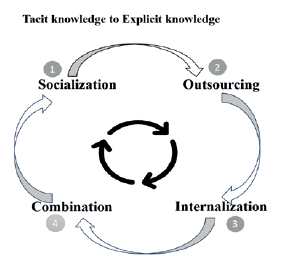
Note: forms of knowledge conversation.
Source: adapted from Nonaka y Takeuchi (1994).
Figure 1 Forms of knowledge conversion
Innovation. Contributions: it is the term used to define the significant improvements on products and services, giving an added value that allows improving the profitability of the process from its use. According to Van Boxtel (quoted by Shafi et al., 2019), in order to survive in the market, organizations must change their strategies to innovate their services and products to survive in the market. Thus, the difference between the concept of creativity, which is related to novelty and innovation, is based on the need to generate rentability from the invention during its adaptation in the organization.
Statistical Office of the European Communities and the Organization for Economic Cooperation and Development (OCDE & EUROSTAT, 2018) establish four types of innovations: product, process, organization, and marketing. This division shows the primary forms of innovation, focusing on the characteristics of each dimension by which the process can be defined with.
Open Innovation. According to the European Commission (2016), it is the one that stimulates the internal innovation of organization from the external institutional experiences that favor its constant evolution. This concept defines the relationship of the innovation process with the participation of the entities, united in the consolidation of progress. As stated by García (2015), innovation is an intense activity of knowledge that can generate co-learning strategies based on the exchange of knowledge. In this order of ideas, open innovation creates new possibilities in co-development settings, which can be described as determinant alternatives for the elaboration of new products, services and processes.
Textile Handicraft Activity. It is the work developed on the basis of textile products obtained from a manual process that has as an objective the production of handicrafts through the cross-linking of fibers that can be supported by mechanical tools. This production process is mechanized as part of the experience and repetitive practice of its procedures. According to Artesanías de Colombia, (2019) sheep wool weaving is a textile activity produced by shearing, washing, spinning, and weaving to obtain garments and handicrafts. Vaananen and Pollanen (2020) point out that craftmanship, in short, is a purely creative and intentional process that essentially combines the craftsman's skill with the management of techniques and materials in the interaction with their elements. It can be highlighted that this involves to a greater extent the capacity of the artisan master, and his labor is determined by the time and dedication he invests in the production of individual garments, the quality of which cannot be compared with the industrial substitutes.
Co-creation. It is a crucial factor for innovation processes; it gathers different organizations or groups to consolidate solutions, allows the integration of different views of the same situation, and generates actions that favor the strengthening of common factors in this process. Shamsuzzoha et al. (2016) assert that impresario collaboration, co-creation, and co-development can promote innovation in economic sectors and allow organizations to generate superior results.
Heritage Education.Van Doorsselaere (2021) considers heritage education as a set of educational practices that recognize heritage as a formative resource in the development of teaching and learning, strengthening the conception of history (p. 7). This type of education is described as an interaction between the education of one context and the identification of its heritage, which must lead to social initiatives focused on cultural representations to strengthen the appropriation of the participants.
Social Innovation. These are new processes to solve the communities' problems in alternative ways. Cajaiba (2014) points out that social innovation can be seen as centered on the agent; in other words, generated by the actions of concrete individuals, as another structuralist that is determined by the external context. Eraso et al. (2021) affirm that social innovation is the creation of new ways of doing things between people and between organizations, with the intention of solving problems. The importance of fostering new ways to promote solutions to social problems should be noted based on the innovative ideas that contribute to generating change.
Textile-artisanal Practices. It is the technique that artisans use creatively and ingeniously to transform raw materials into domestic and personal objects for daily use. It is a process that allows the designing of trending home and clothing items through weaving. To talk about the preservation of artisanal textile practices, it is necessary to highlight what has been proposed by Mazzarella et al. (2017) regarding the loss of craft knowledge generated by the closure of factories due to foreign competition, which reduces activity and affects the rentability of the job. For his part, Gómez (2020) points out that to preserve craft knowledge, it is necessary to guarantee the economic sustainability of the artisans, allowing them to meet their needs without resorting to other activities.
Intercultural Education. It is an inclusive approach in which respect and cultural diversity prevail. In this sense, Sánchez (2018) defines it as a learning process that allows the reconfiguration of the cultural and historical meaning of belonging. Hernández (2020) highlights the importance of establishing an intercultural education as an axis of the specific problems of the community. Intercultural education allows the stimulation of intercultural processes depending on the approach of the environment itself, which favors its development.
METHODOLOGY
Kind of Investigation. Descriptive research was privileged from the exploratory study, which made evident the dynamic implementation of the knowledge management model based on the social co-building with the interaction of expert artisans masters on the topic of weaving and students of a local school, where social innovation significantly reduces the disappearance of artisanal textile traditions. Based on the previous, it should be noted that the description allows the comprehension of aspects of the populations under study based on exploratory studies, such as Hernández et al. (2014), who define them as a basis for characterizing people, communities, and processes.
Investigative Approach. It was conducted through the mixed design, which integrates the deductive-inductive analysis. According to Hernández et al. (2014), the main challenges in areas of knowledge related to social and educational research were identified. Therefore, the starting point of the research was an exhaustive search of the literature, for which databases such as Scopus and Web of Science were used, where a global biometric analysis was carried out.
Figure 2 shows the bibliometric networks of the articles found based on the preset evaluation of the search, where we can see 4 main clusters that are distributed on 23 items and 90 links. As observed in the distribution of the nodes, innovation is directly related to the use of living laboratories in the textile design process. It highlights innovation as the main axis, allowing us to see a large part of the studies in the figure related to this topic with a yellow color.
For this phase of the implementation of the model in the work field, the knowledge that the population under study had at the beginning of the investigation about the management of understanding and interculturality of the artisanal textile processes was verified in the initial phase through the application of surveys to both teachers and students of the ninth and tenth grade of the educational institution.
In the first moment, a survey was applied to 11 teachers of the educational institute Liceo Holcim, which is part of the social responsibility programs of the multinational Holcim, with a subsidiary in Nobsa, Boyacá, which is located in the Camilo Torres neighborhood of that municipality. The survey was based on 16 context-characterized questions of the Likert scale type, which allowed the comprehension of the started conditions to evaluate the proposed knowledge management model. It is noteworthy that during the first contact with the educational context, the evaluation of the efforts made by the educational institute to preserve the cultural knowledge of the region was determined, which is detailed below.
RESULTS
Proposed Knowledge Management Model
This model primarily aims to promote the preservation of artisanal textile practices as a social innovation strategy focused on reducing the acculturation of these practices. As described by Mazzarella et al. (2017), social invention refers to the artisanal textile sector, which seeks to promote the rescue of cultural heritage through the interaction of its participants. For its part, social sustainability must ensure compatibility between the culture and values of people, strengthening the identity of the communities in parallel with the economic process and allowing it to be preserved for future generations (Moya-Espinosa & Moscoso-Durán, 2017). The model establishes as an essential axis the social compromise, of the different participants through, a community ecosystem that pretends to stimulate the cultural identity of the local school students through knowledge management on the weaving practices as a fundamental part of the daily chores of its inhabitants. Figure 3 shows the processes used in the planned social innovation approach.
The figure shows the knowledge management model created to promote the preservation of artisanal textile knowledge. This systematic and cyclical scheme is composed of a core determined by the four stages of knowledge transmission. This derived sub-process symbolizes the interactions in the social context, stabilizing itself as a preliminary base for the construction of a social innovation ecosystem, which derives in new stages generating auto-protection of the intangible resources, such as the knowledge of the traditions. Next, it would describe the main components of the model.
Core or Center. This is the core part of the model, composed of the knowledge spirals planted on the model of Nonaka and Takeuchi (1994), which describes the four stages of knowledge management: socialization, externalization, combination, and internalization. Therefore, it confers the balance to the system connecting all the parts, which allows linking the different variables in a standard way.
Co-creation Process. This section, located at the top of the model, describes the different interactions developed to establish the linkage of social actors within the model. In this sense, at the end of the section, two important foci are found: social innovation and intercultural education, which are considered transcendental because they delimit the type of approach to be developed among the participants.
Knowledge Transfer Process. This section of the model presents the processes related to the development of living laboratories, new methodologies and lessons learned through various interactions that develop specific aspects of knowledge transfer, where the links established regarding lessons learned and the development of new methodologies are shown as the focal points of contact between other sections. Therefore, this section promotes innovation in different environments and the connection between process participants. Additionally, these sections seek to encourage the use of the lessons learned as a tool of improvement from one method to another, which is also strengthened with the help of ICT tools that potently store this kind of knowledge in a digital format for constant and timeless use.
Lateral Sections or Variable Boxes.
In this section, the model presents two variable boxes that make it possible to establish a solid connection between the upper and lower sections, or double track, in which an axis of innovation is set, consolidating the transfer of knowledge processes from the relationships between the participants, or the identification of key actors that actively connect new actors through knowledge transfer, generating new methodologies that favor the innovation as the development axis of the ecosystem.
Outer Ring or Cycle of Interculturality.
Finally, on the outside, you can see the cycle of interculturality, which represents the continuity of the processes, either in parallel or developed as part of successive cycles. In other words, it means the replicability of new strategies based on evidence and lessons learned, among which the use of ICT tool to improve their service and usefulness stands out.
The proposed model of knowledge management presents a systemic design resulting from various aspects consulted and validated with experts and social actors of the community under study. Thanks to the systematic review of the literature, it was found that there is little information available on the subject; in addition, it was demonstrated that the knowledge management of artisanal textile knowledge is a rare practice worldwide.
Initial Validation of the Proposed Knowledge Management Model
In the initial stage of the fieldwork, the designed model was socialized and validated with a focal group in a face-to-face meeting that brought together different social actors from the community. Then, through a guided conversation, fundamental aspects of the created model were identified, including its importance in preserving identity and its use within the community as a tool for social innovation. This exercise was carried out in the workshop: "Tejiendo Ruana, Tejiendo Realidades", which allowed the model to be complemented by the opinions of the different social actors of the community.
Figure 4 shows the process of validation and approval of the model developed during the focal group, which also took into account different opinions from a written questionnaire that asked about seven critical aspects of the model. In addition, a sample was selected to analyze the results of all attendees. The 100% approval of the model by the participants confirmed the unanimity of their feelings.
The last figure shows the contributions of the different social actors of the community that participate in the Tejiendo Ruana, Tejiendo Realidades workshop. The workshop had seven open questions that served as a basis for discussion of the local context. In this way, it took up relevant aspects of the research carried out, among them, the perception of the participants on factors such as the past, present, and future of textile crafts, innovation, and knowledge management; education and the ideal of the artisanal textile products of the community.
As shown in the previous figure, through the analysis of the data from the focal group, the typical characteristics of the different social actors of the municipality were identified, which are essential for the research contributions. This makes it possible to define the initial situation of the municipality and the importance of carrying out the pilot test of the model. In this way, keywords were identified: education, knowledge, innovation, transmission, craft and workshop. It highlights the concepts such as the transmission of craft knowledge, promotion of innovation, knowledge management, educational processes, and craft training.
Co-creation Workshops and Living Laboratories. In relation to the co-creation spaces developed from the described model, the use of the intellectual capital of the artisan weavers was determined fundamental, consolidated as part of the appropriation of the cultural traditions, providing management training spaces intercultural education and innovation between different populations and participants that strengthened the process. Coming up with subsequent collaborative work, co-creation, and the use of living laboratories stand out.
Living Laboratories and Co-construction. During the implementation of the model, living laboratories were created to allow the linking of local co-creation spaces for the formulation, planning, and development of solutions to the problems of the context, offering collaborative processes that fostered open and participatory innovation processes in the community, managing to establish action plans focused on strengthening these techniques. Lorenzi and Sanches (2019) agree that these open spaces encourage the creation of new ideas, which go beyond technical innovation and relate to craft processes.
Likewise, the age of the artisans has been established as an essential transversal axis in the development of the proposed management model, since this is the most obvious characteristic in view of the risk of the disappearance of these skills, considering that the artisans are the true connoisseurs of the artisanal textile processes and in whose intellect reside the essential knowledge for the preservation of the cultural traditions that are also part of the patrimony and heritage of the Muisca people.
Knowledge Transfer Process. The active participation of the actors in the different phases of the management process encourages the promotion of the innovation capacities of artisans, with the intention of transforming tacit knowledge into explicit knowledge to unify it for teaching, encouraging the improvement of the techniques developed and promoting more specific educational processes through aspects such as understandable examples for the learners. Lorenzi and Sanches (2019) state that the creation of a flexible educational project allows the trend of open projects of educational learning to apply information management within them.
Descriptive Analysis. It was constituted by the reasoning that allowed representing and observing the behavior of the data, as shown below:
First Process. Initial valorization of the teachers' perspective on the intercultural situation of the educational process. This assessment allows us to state that the efforts developed by the educational institution are quiet sufficient for the preservation of cultural traditions; this was stated by 45.5% of the respondents; furthermore, it was stated that none of the teachers surveyed considers the school's actions to be sufficient to address issues related to interculturality in the educational process, which shows the need to preserve the local heritage based on the textile-artisanry to strengthen the educational process on intercultural topics.
Second Process. For the recollection of information, a characterization survey was applied to 49 students of ninth and tenth grades of the educational institution, with 15 questions of the Likert type, to evaluate their level of appropriation of the artisanal textile issue. In this regard, specific aspects related to the kind of knowledge were determined, for example, the experience in manufacturing textile handicrafts and family characteristics concerning knowledge of weaving techniques. Among the aspects that stand out is the distribution between women (53%) and men (47%) in the courses that were part of the sample. Figure 8 highlights that the number of male students is not so different from the number of women, which is a favorable aspect for developing the pilot test of the model that supports this article. The previous allows establishing an equitable process in terms of gender to establish the relationship between the preservation methods of artisanal textile knowledge and the leakage of knowledge and the acculturation of artisanal textile practices in the community.
Another remarkable aspect of the acculturation process is the family environment that carries out the textile artisan activity, as shown in Figure 9. It can be noted that 83.7% of the students interviewed did not have people in their family nucleus dedicated to textile artisan activity. On the other hand, the survey revealed that only 16.3% of the respondents stated that they had at least one person in their family nucleus who was familiar with textile artisanal knowledge. Thus, it was possible to identify that the knowledge leakage is associated with the small population of students with a family environment close to the textile artisan traditions.
Figure 10 shows the level of affinity of the new generations to textile artisanal entrepreneurship as part of their life project; faced with the preservation of these traditions in the future, only 6.1% of the students declare that they have a high interest in implementing these processes as part of their life project.
From Figure 10, It was established that most of the respondents have a medium interest in the possibility of having an artisanal textile enterprise as part of their life project. This is further evidence of the notorious tendency of the acculturation process of artisanal textile practices. The previous allows us to see social innovation as a specific and pivotal resource to consolidate the rescue of this ancestral tradition.
Regarding the 37 artisans who participated in the study, a survey that consisted of 17 Likert-type questions was applied, which allowed the identification of relevant aspects in terms of artisanal textile knowledge and the transmission of artisanal textile knowledge, which favored the strengthening of the knowledge management model that supports this article.
Figure 11 shows that a significant part of the textile artisans of the municipality are women, which recognizes the women's labor in the preservation process of the traditions. Continuing with the integrative proposal of the knowledge management model, which is explained later, the model integrates both men and women into an educational process without any undervaluation for developing textile crafts.
Regarding the specific knowledge of weaving at the local level, it was determined that there are artisanal textile weaving techniques that are very rarely practiced by artisans and are at high risk of disappearing. Therefore, the need to prioritize these techniques within the processes of preservation of the cultural and intangible heritage of the municipality of Nobsa was established.
In the figure above, critical aspects within the artisanal textile context are identified as evidence of some types of weaving that are more likely to disappear. This intellectual and intangible asset present in the economic and cultural processes of the community must be strengthened based on the development of value propositions that can be promoted through the co-construction of solutions at the community level.
Figure 12 shows the average age of the artisans, which was decisive in measuring the impact of knowledge leakage in the early stages of the study.
Regarding the age of the artisans, most of the respondents, i.e., 43.2%, are over 51 years old; followed by 24.3% of respondents between 44 and 50 years old, while 10.8% of artisans are between 15 and 25 years old. The above could be considered as evidence of the acculturation process, which guarantees that this type of process in the future becomes an element of interest for the proposed model, which aims to promote the preservation of textile craft practices focused on social innovation processes with the involvement of the young population guaranteeing the continuity and preservation of knowledge.
CONCLUSIONS
Thanks to this study, it was established that the model contributed to the transmission of ancestral knowledge. In the same way, based on the data obtained from the surveys applied to the artisans and the students, it was proven that the processes developed by the educational institution were limited in terms of the transmission of artisanal textile knowledge, focused both on the attachment of culture and the promotion of cultural entrepreneurship. The previous did not determine a direct way to promote the transmission of artisanal textile knowledge in intercultural processes.
With regard to the characterization of the artisan textile activities developed during the implementation of the Living Laboratories, it was observed that the competitiveness of the sector was a determining factor in the transmission of knowledge to the new generations, where it is observed that this type of process is not usually seen reflected in the life projects of the students.
On the other hand, the way in which the knowledge management model addressed the aspects determined by the knowledge spiral described by Nonaka and Takeuchi (1994) during the pilot test was established. The creation of collaborative spaces between public and private entities were generated, from which social innovation proposals were consolidated, promoted competitiveness and the improvement of knowledge transfer methods. This favors the image of the sector and reduces the uprooting of the cultural traditions that cause the leakage of knowledge in the students of educational institution.
The dynamic nature of the implemented knowledge management model has allowed, from living laboratories and co-creation, to achieve favorable conditions that favored the preservation of artisanal textile knowledge as part of non-formal education processes and community processes, becoming a benchmark for new research that promotes economic development based on cultural traditions that tend to save them.















